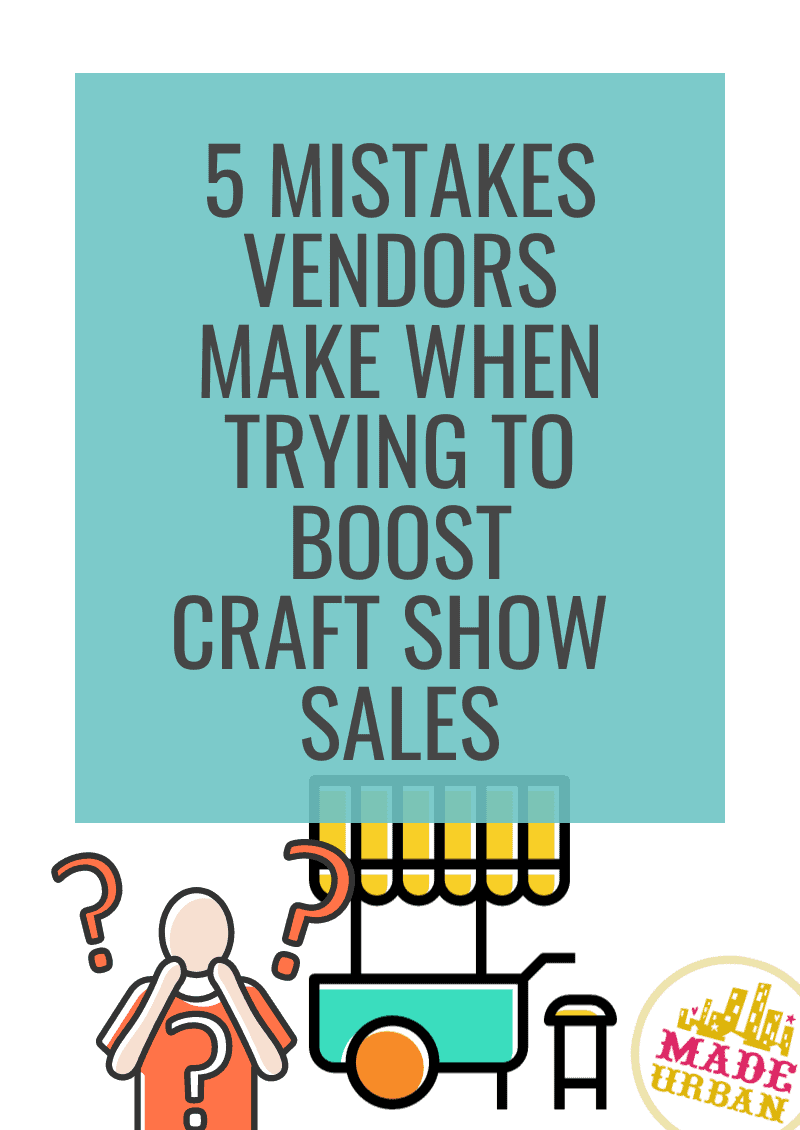5 Mistakes Vendors Make when Trying to Boost Craft Show Sales
If you sell at enough craft shows, chances are, you’ve dealt with disappointing sales at some point.
When low craft show sales are reoccurring, you may start making one or more of these mistakes in an attempt to boost sales.
1) Adding more stock
When the products on your craft show table aren’t selling, it’s tempting to add more items in hopes of attracting more shoppers, or different types of shoppers.
Unfortunately, this often hurts sales.
If your current product selection isn’t selling, it is a good idea to make changes. However, it’s important to edit your selection; not simply add to it.
As explained in this study, too many product options reduce how many people buy.
There are several reasons this happens. You can read more about that here: How your Creativity is Killing Sales
Instead of randomly adding new products, look at your sales stats.
>> Here are 7 sales stats you should be tracking at craft shows (plus free tracking worksheets)
Find types of products, product prices, product features, etc. that you’ve sold the most of and let that direct your product decisions.
Think about:
>> The message your products collectively send. Does your table say “I dabble in a variety of crafts” or “I’m an expert at making one type of product”?
>> How your products work together. If someone is interested in buying a candle, what other candle-related items might they want? A candle buyer isn’t also going to buy a knitted scarf or a pair of earrings in the same transaction.
>> How do your products look together? Your craft show selection should look thoughtfully curated. A mix of clashing colors and patterns will lower the perceived value of your products.
Consider what type of craft business you want to be, the target market you want to serve, and the products they need. Then adjust your product line accordingly.
2) Making too many changes, too fast
Although you may need to make changes to your product selection and/or display, doing so too quickly or too aggressively (i.e. changing too many elements at once) will make it hard to determine which changes were effective.
Make changes based on stats and shopper behaviour.
Don’t wipe out your entire product line and introduce all new products. Instead, introduce one new product (or type of product), highlight it in your display, and remove or give less space to a product that doesn’t sell well.
Assess how that one change impacts shopper behaviour and/or sales, and use that information to spark your next change.
3) Pushy sales tactics
When you’re halfway through a craft show and your sales aren’t where you’d like them to be, you may start to feel a little more desperate and act more pushy.
Jumping on shoppers as soon as they approach, going into long sales pitches, offering to lower prices if they buy, etc. will repel more shoppers than attract them.
Although you may not be the type of person to start using aggressive sales tactics, you may start watching shoppers more intently, hoping they’re going to buy. This can make them feel uncomfortable and leaving your space quickly.
Try to remain calm and create an inviting atmosphere for people to shop in.
4) Disengaging
It’s easy to go in the opposite direction of being pushy and instead become uninterested in craft show shoppers.
Craft shows are a wealth of information for small business owners.
When a shopper is at your table, use it as a learning experience.
Without making them feel uncomfortable, pay attention to:
- Which items are shoppers drawn to first?
- What do they pick up the most?
- What items are completely ignored?
You may even ask shoppers specific questions. You can let them know you’re working on improving your craft business and would love their feedback.
If you don’t have many shoppers at your table to analyze, watch shoppers at other vendor’s booths.
Pay attention to the types of booths shoppers are drawn to and find commonalities; it may be a category of product, size of product, price point, etc.
5) Copying
It’s important to “study” craft show shoppers and see how they interact with other booths and products.
You can make changes to your business based on shopper behaviour, but you shouldn’t copy the “popular” booths.
Not only is it a bad look in the tight-knit crafting community, but you’ll always be a step behind.
When your ideas come from within, you’ll never be short on them. If you need to look at what others are doing, you’ll never be the first to market.
Noticing that accessory booths tend to be the most popular and pivoting into selling hair accessories or bags instead of pillows is okay.
On the other hand, it isn’t a good idea to start making boho flower crowns after seeing how popular a boho flower crown booth was at a recent craft show.
Explore unique positions for your craft business and work on developing your signature style based on your strengths and creativity.


Hey, I’m Erin 🙂 I write about small business and craft show techniques I’ve learned from being a small business owner for almost 2 decades, selling at dozens of craft shows, and earning a diploma in Visual Communication Design. I hope you find my advice helpful!
